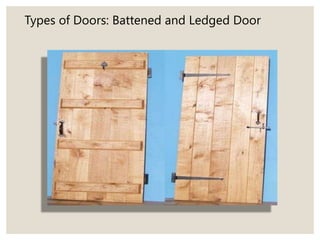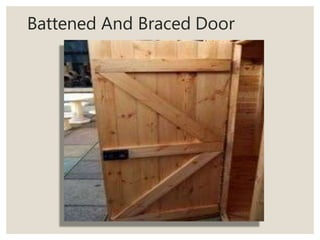Lecture 1 Building types and components of building.pptx
- 1. What Is Building A structure with walls and a roof standing more or less permanently in one place is commonly known as a building. For example a house or factory. Buildings serve several societal needs – primarily as shelter, living space, privacy & security, to store materials, workspace, etc. In this lecture in first part we will discuss different types of buildings, and than components of building will be discussed.
- 2. Part 1 Types Of Buildings: Types of buildings may be classified in two ways: 1. On the basis of its use, 2. On the basis of Structure.
- 3. Classification based on type of use: Depending upon the character of occupancy or the type of use, buildings can be classified into different categories as follows: 1. Residential Buildings: 2. Educational Buildings: 3. Institutional Buildings: 4. Assembly Buildings: 5. Business Buildings: 6. Mercantile Buildings: 7. Industrial Buildings: 8. Storage Buildings:
- 4. Residential Building Residential building means a private building. A residential building is one that is planned and in like manner worked for occupants to live.
- 5. Educational Building Educational building means a building exclusively used for a school, college or University, recognized by the appropriate Board/ University/Council .
- 6. Any building or a part of building which are constructed by government, semi-government organizations or any registered trusts used for purposes like medical or other treatment, physical or mental illness institutes, auditoriums, children hospitals, old age homes, etc. are included into the institutional buildings. Institutional Building
- 7. Any building or a part of a building like theaters, assembly halls, auditorium, museums, exhibition halls, club houses, dance halls, sports stadiums, transportation service such as bus stops, railway stations, airports, taxi stands, etc. where groups of people gather for entertainment, travel, religious purpose, programs or other similar works. Assembly Building
- 8. Business Building Any building or a part of building which is used for business purpose and used for transaction of business, work or accounts for purposes like shops, beauty salons, barber shops, banks, launch counters, food courts, breakfast stalls, professional corporate offices
- 9. These shall include buildings used for shop, markets, stores, wholesale or retail. Mercantile Buildings
- 10. Industrial Buildings These types of building are mainly used for manufacturing purposes. Here products or materials of all kinds and properties are fabricated, assembled, or processed, for example, gas plants, refineries, mills, dairies, etc.
- 11. StorageBuildings These buildings are generally used for the storage or sheltering of goods, wares, or merchandise like warehouses, cold storages, garages, stables, transit sheds, etc.
- 12. Hazardous Buildings This building is used to store, handle, or manufacture highly corrosive, toxic, acid or other liquids or chemicals that produce flame, fumes explosives, etc.
- 13. Classification Based On Structure • Load bearing Structure • Framed structure • Load Bearing Structures: In this type of structures loads from roof slab or trusses and floors are transmitted through walls to the firm soil below the ground .This type of structures are available at elements like beams, slabs rests directly on walls.
- 15. • Framed Structures: Reinforced cement concrete structures are the most common type of construction today. They consist of a skeletonof beams & columns. The load is transferred from beams to the columns and column intern transfer the load directly to the sub soil through footing. Framed structures are suitable for multi-storey building subjected to variety of extreme loads like compressive, tensile torsion, shear along with moment. • The open spaces in the skeleton are to be filled with brick walls or glass panels. Framed Structures
- 17. Part 2: Elements of Building Construction
- 19. Super Structure • The superstructure is that part of the building which is above the ground and which serves the purpose of building’s intended use. • It includes: • Plinth level, Sill level and Lintel level • Wall , Slab, columns and Beams • Floors and Roofs • Parapet • Steps and stairs
- 20. Substructure • The substructure is the lower portion of the building, which is located below ground level which transmits the load of the superstructure to the sub soil.it includes • Foundations
- 21. Foundation • The basic function of foundation • Transmit the load from building to the subsoil, in such a way that i. settlement are within permissible limit ii. the soil does not fail in shear iii. Reduce the load intensity iv. Even distribution of load v. Provide level surface
- 22. Types Of Foundation • Foundations may be broadly classified as • (a) Shallow Foundation • (b) Deep foundation • (a) Shallow Foundation Spread footing Combined footing Grillage Foundation Mat Foundation or Raft Foundation
- 23. Spread Footings
- 24. Combined Footing
- 27. Deep Foundation • Deep foundation may be of following types i. Pile foundation ii. Pier iii. Well or caissons
- 28. Pile Foundation:- Pile Foundation is that type of foundation in which the loads are taken to a low level by means of vertical members which may be timber
- 29. Pier Foundation: A Pier foundation consist of cylindrical column of large diameter to support and transfer large superimposed load to the firm strata below.
- 30. Well Foundation
- 31. Super Structure: The superstructure is that part of the building which is constructed above the plinth level.
- 32. Plinth level, Sill level and Lintel level • Plinth level means the level of the floor of a building immediately above the surrounding ground. • This level between the base portion of the window and portion of the floor above ground level (upwards) is called the Sill level. A mortar bed or concrete bed is laid at the base of the window. • The level between the top portion of the window and the top slab is called the Lintel level.
- 33. Wall Wall is a structure defining an exact area and providing safety & shelter. There are various types of walls used in the construction of buildings given below. The construction of walls depending upon the types of material. According to material, these are mainly classified as: 1. Brick masonry, 2. Stone masonry, These are used to transfer the load from the roof to plinth beam. These are also providing support to the building in some cases.
- 34. Walls
- 35. Columns are vertical members along which beams and slab /roof is supported. They are square, rectangular and circular in shape. Columns
- 36. Beam A beam is a horizontal structural member in a building to resist the lateral loads applied to the beam’s axis.
- 37. Roof/ Slab Roof: The upper most part of the building constitutes the roof. The Slab and roof encloses the space and offers protection from rain, heat, snow, wind, sound, fire
- 38. Floor: A floor is a plane area to support occupants, furniture's, and equipment. Floor
- 39. Doors And Windows • A door provides a connecting link between rooms, allowing easy free movement in the building. Window are opening provided in walls. • Doors and windows provide lighting and ventilation. The provide resistance to weather, sound and heat. They provide security and privacy
- 40. Sizes of Doors • For ResidentialArea • Internal doors 0.9 x 2.0 m • External doors 1.2 x 2 m • Door for bath and w.c. 0.75 x 2.0 m • Industrial Buildings • Width 1.5, 2.0, 2.5 m • Depth or height 2.0 m, 2.5 m
- 41. Battened And Ledge Door Types of Doors: Battened and Ledged Door
- 42. Battened And Braced Door
- 43. Framed And Panneled Door
- 44. Glazed Door
- 45. Flush Door
- 46. Louvered Door
- 47. Revolving Door
- 48. Sliding Door
- 51. Sizes of Windows • Sizes of Windows: 0.6, 0.75, 0.9, 1.0, 1.2, 1.8m • Depth: 0.6 0.75, 0.9, 1.0, 1.2, 1.5, 1.8 m • Size of Ventilator: Width= 0.3, 0.45, 0.6, 0.75, 0.9 m
- 52. Pivoted Window
- 53. Double Hung
- 54. Sliding Window
- 55. Casement Window
- 56. Sash Window
- 57. Louvered Window
- 58. Corner Window
- 59. Bay Window
- 60. Dormer Window
- 61. Gable Window
- 62. Skylight Window
- 63. Steps and Stairs • In one flight maximum 8 steps should be provided for more than 8 steps it is • Steps and stairs are meant to provide access between different levels. Stairs should be properly located to provide easy access and fast services to the building. recommended to provide them with lending. • Generally for residential building width of stair is 1.0 m and 1.2 m • No of risers= Total height of floor/ Height of riser • No of tread= Number of riser-1
- 64. Steps and Stairs
- 65. Types of Stair Case
- 66. Parapet • Parapet: partition Parapet is generally 10 cm thick wall constructed above slab to enclose the terrace open to sky. Thickness is 10 to 15 cm height is 1.0 m to 1.2 m

































































